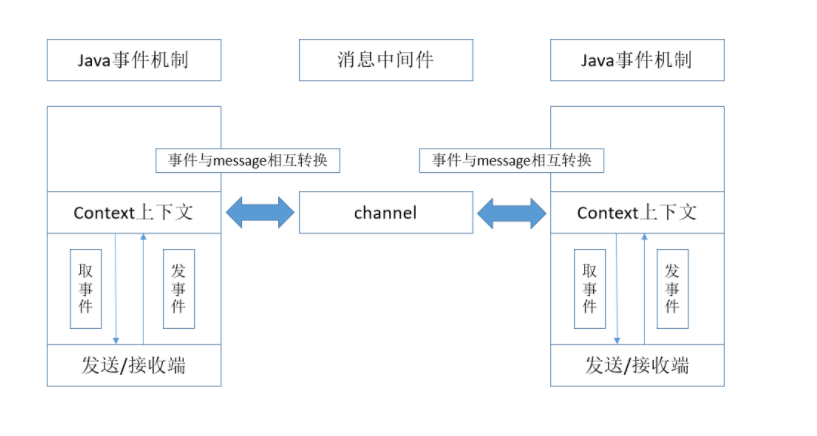首先springcloud_bus原理:

(1)完整流程:发送端(endpoint)构造事件event,将其publish到context上下文中(spring cloud bus有一个父上下文,bootstrap),然后将事件发送到channel中(json串message),接收端从channel中获取到message,将message转为事件event(转换过程这一块没有深究),然后将event事件publish到context上下文中,最后接收端(Listener)收到event,调用服务进行处理。整个流程中,只有发送/接收端从context上下文中取事件和发送事件是需要我们在代码中明确写出来的,其它部分都由框架封装完成。
(2)先大致描述了一下流程,关于封装的部分流程,我们基本上可以在BusAutoConfiguration.class中找到,下面的代码都是这个类中的代码
@EventListener(classes = RemoteApplicationEvent.class)
public void acceptLocal(RemoteApplicationEvent event) {
if (this.serviceMatcher.isFromSelf(event)
&& !(event instanceof AckRemoteApplicationEvent)) {
this.cloudBusOutboundChannel.send(MessageBuilder.withPayload(event).build());
}
}
这是封装了java事件处理机制,当收到RemoteApplicationEvent时,如果这个event是从这个服务发出的,而且不是ack事件,那么就会把这个事件发送到channel中。
@StreamListener(SpringCloudBusClient.INPUT)
public void acceptRemote(RemoteApplicationEvent event) {
if (event instanceof AckRemoteApplicationEvent) {
if (this.bus.getTrace().isEnabled() && !this.serviceMatcher.isFromSelf(event)
&& this.applicationEventPublisher != null) {
this.applicationEventPublisher.publishEvent(event);
}
// If it's an ACK we are finished processing at this point
return;
}
if (this.serviceMatcher.isForSelf(event)
&& this.applicationEventPublisher != null) {
if (!this.serviceMatcher.isFromSelf(event)) {
this.applicationEventPublisher.publishEvent(event);
}
if (this.bus.getAck().isEnabled()) {
AckRemoteApplicationEvent ack = new AckRemoteApplicationEvent(this,
this.serviceMatcher.getServiceId(),
this.bus.getAck().getDestinationService(),
event.getDestinationService(), event.getId(), event.getClass());
this.cloudBusOutboundChannel
.send(MessageBuilder.withPayload(ack).build());
this.applicationEventPublisher.publishEvent(ack);
}
}
if (this.bus.getTrace().isEnabled() && this.applicationEventPublisher != null) {
// We are set to register sent events so publish it for local consumption,
// irrespective of the origin
this.applicationEventPublisher.publishEvent(new SentApplicationEvent(this,
event.getOriginService(), event.getDestinationService(),
event.getId(), event.getClass()));
}
}
@StreamListener这个标签有兴趣的可以去了解一下。这个方法就是从channel中取出事件进行处理的过程(message转事件部分需要自行了解,我没有深入研究),根据事件的类型、发送方和接收方来处理这个事件:如果是ack事件,发送到context上下文中;如果自己是接收端且不是发送端,就会将事件发送到context上下文。
(3)消息中间件可以采用rabbitmq、kafka之类的
(4)说两个比较有意思的问题
1)自定义事件时,我们需要添加无参构造方法:目的在于,在message转事件时,会调用这个无参构造方法,具体情况可以去参考源码看看
2)自定义事件时,事件的参数需要用final修饰,这个一直没有找到合理的解释,有兴趣可以去研究研究
使用:
引入rabbitmq依赖:
<?xml version="1.0" encoding="UTF-8"?>
<project xmlns="http://maven.apache.org/POM/4.0.0" xmlns:xsi="http://www.w3.org/2001/XMLSchema-instance"
xsi:schemaLocation="http://maven.apache.org/POM/4.0.0 http://maven.apache.org/xsd/maven-4.0.0.xsd">
<modelVersion>4.0.0</modelVersion>
<parent>
<groupId>org.springframework.boot</groupId>
<artifactId>spring-boot-starter-parent</artifactId>
<version>2.1.2.RELEASE</version>
<relativePath/> <!-- lookup parent from repository -->
</parent>
<groupId>com.cxy</groupId>
<artifactId>person</artifactId>
<version>0.0.1-SNAPSHOT</version>
<name>person</name>
<description>Demo project for Spring Boot</description>
<properties>
<java.version>1.8</java.version>
<spring-cloud.version>Greenwich.RELEASE</spring-cloud.version>
</properties>
<dependencies>
<dependency>
<groupId>org.springframework.boot</groupId>
<artifactId>spring-boot-starter-amqp</artifactId>
</dependency>
<dependency>
<groupId>org.springframework.boot</groupId>
<artifactId>spring-boot-starter-web</artifactId>
</dependency>
<dependency>
<groupId>org.mybatis.spring.boot</groupId>
<artifactId>mybatis-spring-boot-starter</artifactId>
<version>2.1.0</version>
</dependency>
<dependency>
<groupId>org.springframework.cloud</groupId>
<artifactId>spring-cloud-config-client</artifactId>
</dependency>
<dependency>
<groupId>org.springframework.cloud</groupId>
<artifactId>spring-cloud-starter-netflix-eureka-client</artifactId>
</dependency>
<dependency>
<groupId>org.springframework.cloud</groupId>
<artifactId>spring-cloud-starter-netflix-ribbon</artifactId>
</dependency>
<dependency>
<groupId>org.springframework.cloud</groupId>
<artifactId>spring-cloud-starter-openfeign</artifactId>
</dependency>
<dependency>
<groupId>org.mybatis.spring.boot</groupId>
<artifactId>mybatis-spring-boot-starter</artifactId>
<version>2.0.0</version>
</dependency>
<dependency>
<groupId>mysql</groupId>
<artifactId>mysql-connector-java</artifactId>
<version>5.1.41</version>
</dependency>
<dependency>
<groupId>org.springframework.boot</groupId>
<artifactId>spring-boot-starter-actuator</artifactId>
</dependency>
<dependency>
<groupId>org.springframework.boot</groupId>
<artifactId>spring-boot-starter-test</artifactId>
<scope>test</scope>
</dependency>
</dependencies>
<dependencyManagement>
<dependencies>
<dependency>
<groupId>org.springframework.cloud</groupId>
<artifactId>spring-cloud-dependencies</artifactId>
<version>${spring-cloud.version}</version>
<type>pom</type>
<scope>import</scope>
</dependency>
</dependencies>
</dependencyManagement>
<build>
<plugins>
<plugin>
<groupId>org.springframework.boot</groupId>
<artifactId>spring-boot-maven-plugin</artifactId>
</plugin>
</plugins>
</build>
</project>
然后配置:
bootstrap.yml
spring: cloud: config: profile: dev discovery: service-id: config enabled: true rabbitmq: host: 192.168.230.134 application: name: person
线上配置文件:
https://gitee.com/chenxiufen/springcloudconfig/blob/master/person-dev.yml
然后启动就可以了.